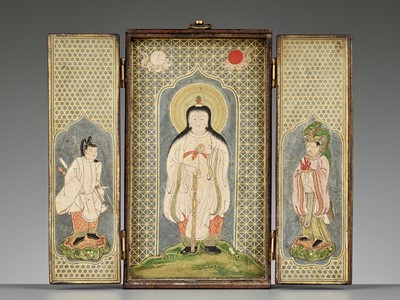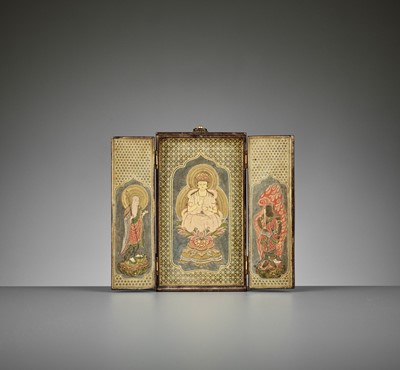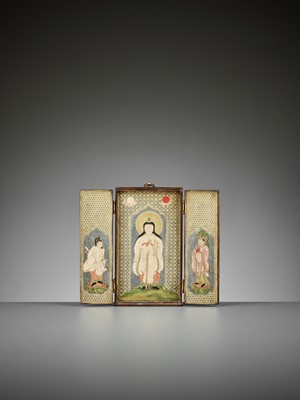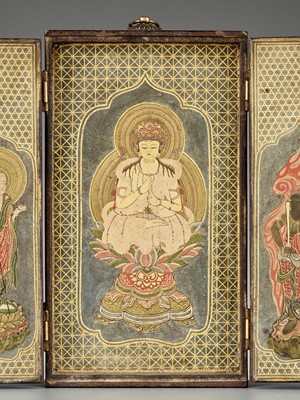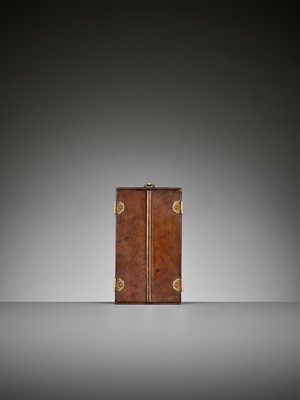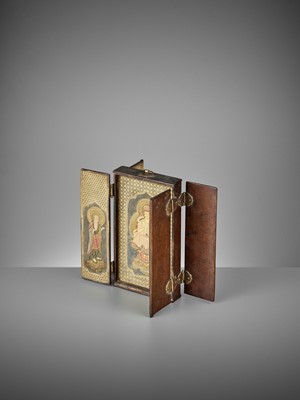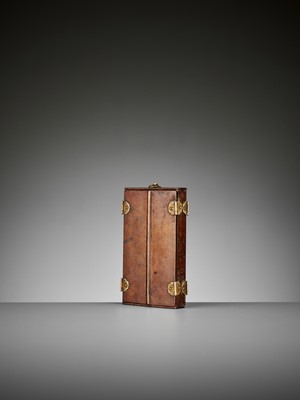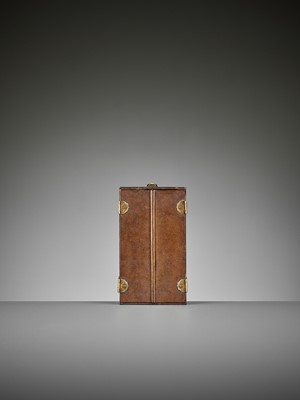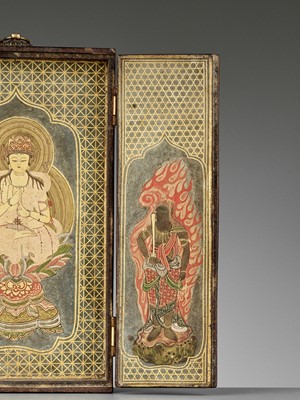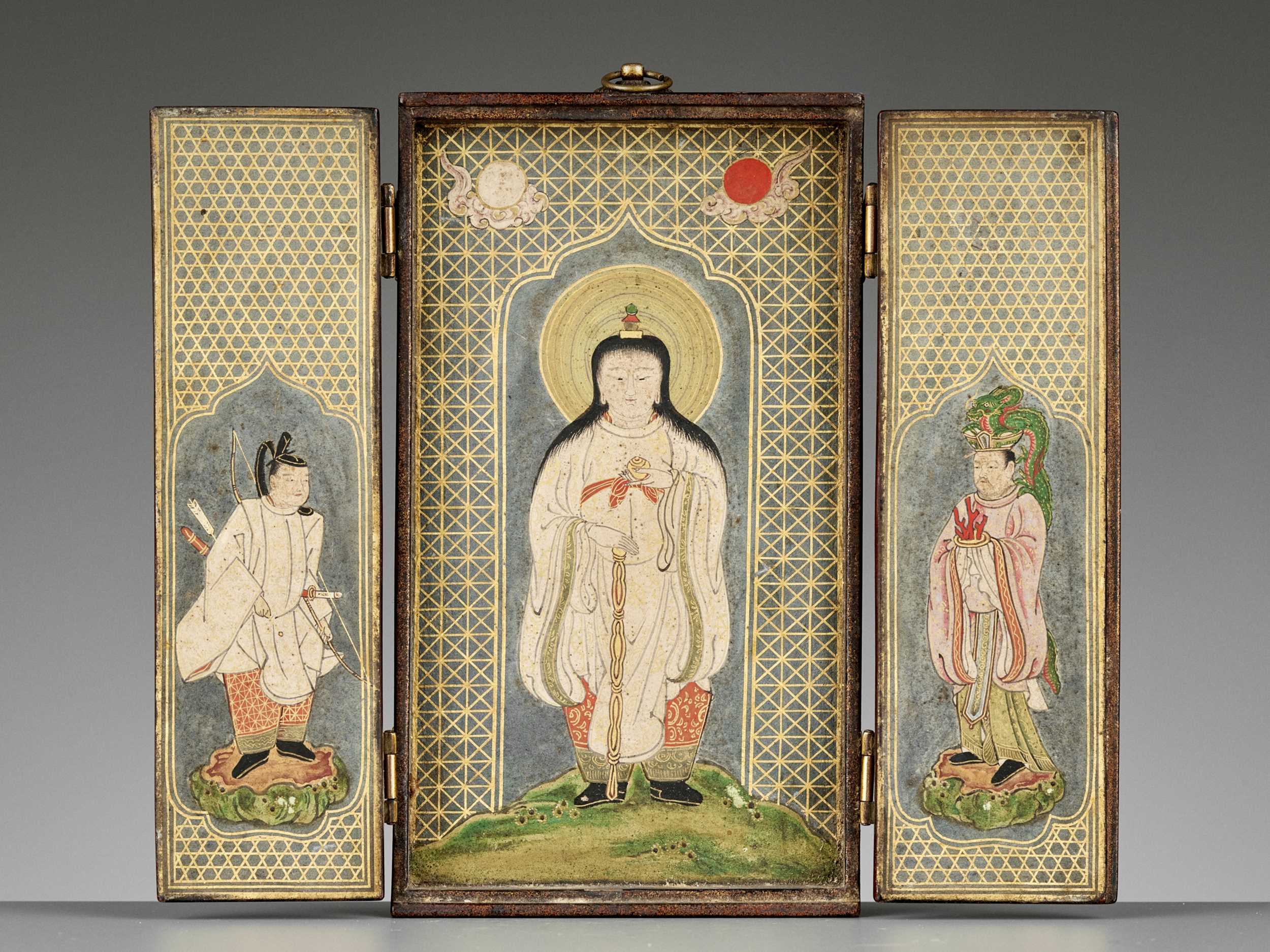4th Jun, 2021 13:00
Fine Japanese Art
128
A MAGNIFICENT DOUBLE-SIDED LACQUERED WOOD ZUSHI (PORTABLE SHRINE) WITH DAINICHI NYORAI AND KISHIJOTEN
Sold for €5,056
including Buyer's Premium
Japan, 17th to 18th century, Edo period (1615-1868)
The rectangular wooden frame lacquered in nashiji in imitation of copper, with two hinged doors on either side secured by gilt brass fittings. Each side opens to reveal a central deity flanked by two further deities, very finely painted with polychrome pigments, gesso, and gold. Each deity is painted within a stupa-shaped reserve framed by a rich gold star-shaped brocade pattern.
One side shows Dainichi Nyorai (Mahavairocana) seated on a lotus throne, the hands held in chiken-in (knowledge fist), flanked by Jizo Bosatsu (Ksitigarbha), holding the wish-fulfilling jewel and staff, and Fudo Myo-o (Acala) holding a rope and sword.
The other side shows Kishijoten (derived from the Indian goddess Lakshmi) standing, holding the wish-fulfilling jewel and a staff, flanked by the dragon god of the sea Ryujin and the god of the hunt Hachiman armed with bow and arrow.
SIZE 14 x 8.5 x 2.5 cm
Condition: Very good condition, with only very minor wear to lacquered exterior and some minuscule losses to edges. The painting on the inside with some minor old wear, in an exceptional state of preservation when considering the age.
Provenance: Old Swiss private collection formed in the 1940s/50s.
The clean and clear iconography of the various deities depicted is quite remarkable in this piece, certainly hinting at an early date of manufacture. Furthermore, the extremely fine painting and double-sided nature of this shrine make this an exceptionally rare artwork.
Literature comparison:
Note the similar star-shaped gold brocade pattern on a star Mandara in the Museum of Fine Arts Boston, accession no. 11.7123.
Japan, 17th to 18th century, Edo period (1615-1868)
The rectangular wooden frame lacquered in nashiji in imitation of copper, with two hinged doors on either side secured by gilt brass fittings. Each side opens to reveal a central deity flanked by two further deities, very finely painted with polychrome pigments, gesso, and gold. Each deity is painted within a stupa-shaped reserve framed by a rich gold star-shaped brocade pattern.
One side shows Dainichi Nyorai (Mahavairocana) seated on a lotus throne, the hands held in chiken-in (knowledge fist), flanked by Jizo Bosatsu (Ksitigarbha), holding the wish-fulfilling jewel and staff, and Fudo Myo-o (Acala) holding a rope and sword.
The other side shows Kishijoten (derived from the Indian goddess Lakshmi) standing, holding the wish-fulfilling jewel and a staff, flanked by the dragon god of the sea Ryujin and the god of the hunt Hachiman armed with bow and arrow.
SIZE 14 x 8.5 x 2.5 cm
Condition: Very good condition, with only very minor wear to lacquered exterior and some minuscule losses to edges. The painting on the inside with some minor old wear, in an exceptional state of preservation when considering the age.
Provenance: Old Swiss private collection formed in the 1940s/50s.
The clean and clear iconography of the various deities depicted is quite remarkable in this piece, certainly hinting at an early date of manufacture. Furthermore, the extremely fine painting and double-sided nature of this shrine make this an exceptionally rare artwork.
Literature comparison:
Note the similar star-shaped gold brocade pattern on a star Mandara in the Museum of Fine Arts Boston, accession no. 11.7123.
Zacke Live Online Bidding
Our online bidding platform makes it easier than ever to bid in our auctions! When you bid through our website, you can take advantage of our premium buyer's terms without incurring any additional online bidding surcharges.
To bid live online, you'll need to create an online account. Once your account is created and your identity is verified, you can register to bid in an auction up to 12 hours before the auction begins.
Intended Spend and Bid Limits
When you register to bid in an online auction, you will need to share your intended maximum spending budget for the auction. We will then review your intended spend and set a bid limit for you. Once you have pre-registered for a live online auction, you can see your intended spend and bid limit by going to 'Account Settings' and clicking on 'Live Bidding Registrations'.
Your bid limit will be the maximum amount you can bid during the auction. Your bid limit is for the hammer price and is not affected by the buyer’s premium and VAT. For example, if you have a bid limit of €1,000 and place two winning bids for €300 and €200, then you will only be able to bid €500 for the rest of the auction. If you try to place a bid that is higher than €500, you will not be able to do so.
Online Absentee and Telephone Bids
You can now leave absentee and telephone bids on our website!
Absentee Bidding
Once you've created an account and your identity is verified, you can leave your absentee bid directly on the lot page. We will contact you when your bids have been confirmed.
Telephone Bidding
Once you've created an account and your identity is verified, you can leave telephone bids online. We will contact you when your bids have been confirmed.
Classic Absentee and Telephone Bidding Form
You can still submit absentee and telephone bids by email or fax if you prefer. Simply fill out the Absentee Bidding/Telephone bidding form and return it to us by email at office@zacke.at or by fax at +43 (1) 532 04 52 20. You can download the PDF from our Upcoming Auctions page.
How-To Guides
How to Create Your Personal Zacke Account
How to Register to Bid on Zacke Live
How to Leave Absentee Bids Online
How to Leave Telephone Bids Online
中文版本的操作指南
创建新账号
注册Zacke Live在线直播竞拍(免平台费)
缺席投标和电话投标
Third-Party Bidding
We partner with best-in-class third-party partners to make it easy for you to bid online in the channel of your choice. Please note that if you bid with one of our third-party online partners, then there will be a live bidding surcharge on top of your final purchase price. You can find all of our fees here. Here's a full list of our third-party partners:
- 51 Bid Live
- EpaiLive
- ArtFoxLive
- Invaluable
- LiveAuctioneers
- the-saleroom
- lot-tissimo
- Drouot
Please note that we place different auctions on different platforms. For example, in general, we only place Chinese art auctions on 51 Bid Live.
Bidding in Person
You must register to bid in person and will be assigned a paddle at the auction. Please contact us at office@zacke.at or +43 (1) 532 04 52 for the latest local health and safety guidelines.
